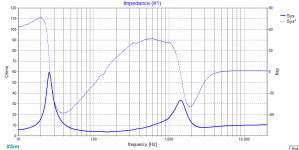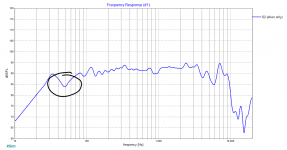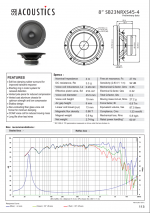I tried modelling Allen's design in XSim just now, and I noticed the system impedance phase stagnates around 45° from 300Hz to 1kHz. That, if I am not mistaken, is a very inefficient state, as the current being is drawn is 50/50 real and imaginary. Correct me if I'm wrong, as always, but is that not something that should be considered in the design of the crossover?
Attachments
After looking through the designs, I think I'll go with Dave/Dougla's design because I agree with that design philosophy the most.
I don't know how soon I can post an update about the progress I will have made, due to the current circumstances. For example, sourcing wood for the cabinet will be tricky.
I don't know how soon I can post an update about the progress I will have made, due to the current circumstances. For example, sourcing wood for the cabinet will be tricky.
A version with a dip may sound more accurate and will have less listening fatigue. This is because of increased odd order HD we are asking the SB23 to play up and into.
What I would do is order parts for both or model variations on one to minimise the number of various able parts. That's the problem with any new passive design. Prepare to have spare xo parts so you can adjust and create a more enjoyable speaker. That's my goal anyway
What I would do is order parts for both or model variations on one to minimise the number of various able parts. That's the problem with any new passive design. Prepare to have spare xo parts so you can adjust and create a more enjoyable speaker. That's my goal anyway
I noticed the system impedance phase stagnates around 45° from 300Hz to 1kHz.
Driver phasing is only really important at the crossover points.
For two electrical signals to have a phase relationship they need to be either the same or harmonically related. Two signals out of phase at the same frequency can cancel each other and you hear a much reduced level.
Of course at the crossover points you have two overlapping drivers reproducing the same signal at the same time. If they are not acoustically in phase (but not necessarily electrically so) you are going to get a loss of output across their shared region.
Other than that... no worries. They are what is known as a rolling wave in that the phase relationship between them is constantly changing and has little overall effect on what you hear.
Last edited:
@douglas I think Kristian is referring to the impedance not frequency response phase angle. Could wild swings with the impedance phase and thus large angles cause a problem with certain types of amplifiers?
@douglas I think Kristian is referring to the impedance not frequency response phase angle. Could wild swings with the impedance phase and thus large angles cause a problem with certain types of amplifiers?
That's a better worded version of my question 😀
A version with a dip may sound more accurate and will have less listening fatigue.
are you referring to the dip at around 2kHz?
@douglas I think Kristian is referring to the impedance not frequency response phase angle. Could wild swings with the impedance phase and thus large angles cause a problem with certain types of amplifiers?
Yes.
oh, I almost forgot. When I buy the crossover components for the crossover prototype I assume I shouldn't buy top-quality components, what type of caps and resistors do you recommend? are bipolar electrolytic caps and carbon film resistors fine or should I get something else?
oh, I almost forgot. When I buy the crossover components for the crossover prototype I assume I shouldn't buy top-quality components, what type of caps and resistors do you recommend? are bipolar electrolytic caps and carbon film resistors fine or should I get something else?
I would go mylar or cheapest polypropylene. And bipolar electrolytically for any values above 20uF
I would buy extra tweeter values for tweeter padding such that you can reduce the response up to 2dB. Tweeter level adjustment is far more significant than using fancy caps.
Put it this way if you hate the sound, you'll be glad you didn't waste money on fancy caps. If you love it you'll be happy for some time and not have many regrets about a fancy cap that the jury is out on whether it would transform the system to another level.
Last edited:
Over the weekend I've built a prototype box to tune the box size and vent dimensions, and I have been troubled by this massive dip in the woofer's FR at 50Hz. It is quite troublesome as it creates a separation between the bass and the mids, making drums, for example, sound off.
I've been trying to think of ways to smoothen this region in the FR, and ive arrived at 2 ideas. First would be to tune the box at 50 Hz to counteract the dip. I am not sure how well this would work, but in my mind it is preferable to the second option. Second would be to add a notch filter at 33Hz to decrease the jump in magnitude. This would be very destructive towards the low frequency performance of the system, hence I prefer the first idea.
I would love some suggestions or pointers to try to get this woofer in line.
I've been trying to think of ways to smoothen this region in the FR, and ive arrived at 2 ideas. First would be to tune the box at 50 Hz to counteract the dip. I am not sure how well this would work, but in my mind it is preferable to the second option. Second would be to add a notch filter at 33Hz to decrease the jump in magnitude. This would be very destructive towards the low frequency performance of the system, hence I prefer the first idea.
I would love some suggestions or pointers to try to get this woofer in line.
Attachments
What are your measurement conditions? Is this an in-room, ungated response?
Have you done an impedance sweep on the enclosure and woofer to see where your tuning frequency is?
Have you done an impedance sweep on the enclosure and woofer to see where your tuning frequency is?
I haven't done any measurements yet, im still waiting for stuff to arrive. That's just the factory FR, and i did the "measurements" by ear.
Factory measurements, your own measurements (in your room, box etc...) and "by ear" are very different things.
I bet you’ll hear your room's acoustic when you mention the bass-midrange "disconnect".
Or rather the speaker and the room acoustical summation.
Also factory measurements can have flaws, they are not necessarily perfect measurements, especially in the low-end range.
I bet you’ll hear your room's acoustic when you mention the bass-midrange "disconnect".
Or rather the speaker and the room acoustical summation.
Also factory measurements can have flaws, they are not necessarily perfect measurements, especially in the low-end range.
Last edited:
I wouldn't worry about the conjecture on crossover approaches or simulation anomalies for the time being. Get a test box made and measured and then you'll have some meat to bite in to.
I'm a little confused about the above graph. You say it is the factory graph but you also built a box?
I'm a little confused about the above graph. You say it is the factory graph but you also built a box?
I'm a little confused about the above graph. You say it is the factory graph but you also built a box?
I've built a box, but I haven't gotten around to measuring its response yet.
I haven't done any measurements yet, im still waiting for stuff to arrive. That's just the factory FR, and i did the "measurements" by ear.
I'm confused sorry.
The graph in post #91 is a factory graph, that you measured by ear? did you use an SPL meter and plot? If so - you could have a room mode. dont worry about it. Won't affect crossover design. If going passive - room placement and treatment is your weapon here, not crossover for dealing with room modes.
#64 contains the factory curve from SBA that I used to base the "in box" simulation on. Neither factory nor in-box contain a 50Hz centred dip.
Anyway graham is right - now you have a test box and mic - post both a raw nearfield and a raw gated farfield for us to look at
Ok, that was unexpected. I wonder about SB's own measurement conditions.
Initially using the TS parameters alone in a box simulator would be the way to get a feel for the box you need.
Now, I'd want to verify the above situation with a nearfield measurement before making any further judgements.
Initially using the TS parameters alone in a box simulator would be the way to get a feel for the box you need.
Now, I'd want to verify the above situation with a nearfield measurement before making any further judgements.
- Home
- Loudspeakers
- Multi-Way
- Designing an 8" 2-way using the SB23NRXS45-4 and SB29RDC-C004


